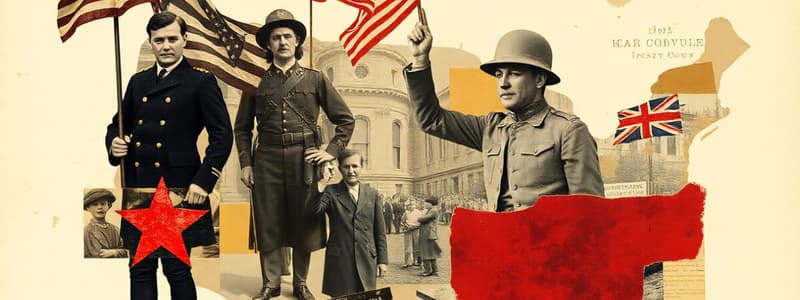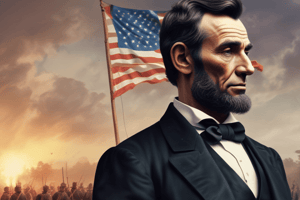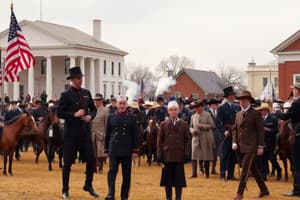Podcast
Questions and Answers
What was a significant impact of the influx of immigrants to American urban centers?
What was a significant impact of the influx of immigrants to American urban centers?
- Decreased job opportunities for existing residents
- Reduction in cultural diversity
- Overcrowding and sanitation issues (correct)
- Growth of industrial innovations
Which of the following was NOT a focus of Progressivism?
Which of the following was NOT a focus of Progressivism?
- Regulating businesses
- Achieving social justice
- Improving living conditions
- Promoting isolationism (correct)
Which progressive figure is known for advocating consumer protection and corporate regulation?
Which progressive figure is known for advocating consumer protection and corporate regulation?
- Woodrow Wilson
- Theodore Roosevelt (correct)
- W.E.B. Du Bois
- Jane Addams
How did muckrakers contribute to the Progressive movement?
How did muckrakers contribute to the Progressive movement?
What sparked discussions about American morality and foreign policy during imperialism?
What sparked discussions about American morality and foreign policy during imperialism?
What was a major consequence of the U.S. entry into World War I?
What was a major consequence of the U.S. entry into World War I?
Which movement aimed to secure the right to vote for women?
Which movement aimed to secure the right to vote for women?
What was a key reason for American expansionism in Latin America and East Asia?
What was a key reason for American expansionism in Latin America and East Asia?
What was one of the primary aims of Reconstruction?
What was one of the primary aims of Reconstruction?
What were the Reconstruction amendments designed to accomplish?
What were the Reconstruction amendments designed to accomplish?
What concept fueled westward expansion in the United States?
What concept fueled westward expansion in the United States?
Which event is associated with westward expansion?
Which event is associated with westward expansion?
What was a significant environmental impact of westward expansion?
What was a significant environmental impact of westward expansion?
What was one of the major consequences of the rise of big business during industrialization?
What was one of the major consequences of the rise of big business during industrialization?
What significant infrastructure development connected the East and West of the United States?
What significant infrastructure development connected the East and West of the United States?
Which of the following was a failure of the Reconstruction era?
Which of the following was a failure of the Reconstruction era?
Flashcards
Reconstruction
Reconstruction
The period after the Civil War (1865-1877) focused on rebuilding the South, reintegrating Confederate states into the Union, and protecting the rights of formerly enslaved people.
Manifest Destiny
Manifest Destiny
A belief that the United States was destined to expand its territory from the Atlantic to the Pacific Ocean.
Westward Expansion
Westward Expansion
The process of moving westward and settling new lands, driven by a variety of factors like land availability, resources, and opportunities.
Jim Crow
Jim Crow
Signup and view all the flashcards
Industrialization
Industrialization
Signup and view all the flashcards
Immigration
Immigration
Signup and view all the flashcards
Urbanization
Urbanization
Signup and view all the flashcards
Big Business
Big Business
Signup and view all the flashcards
Progressivism
Progressivism
Signup and view all the flashcards
Imperialism
Imperialism
Signup and view all the flashcards
Social Darwinism
Social Darwinism
Signup and view all the flashcards
Suffrage
Suffrage
Signup and view all the flashcards
Muckrakers
Muckrakers
Signup and view all the flashcards
World War I
World War I
Signup and view all the flashcards
Treaty of Versailles
Treaty of Versailles
Signup and view all the flashcards
Study Notes
Reconstruction
- Reconstruction (1865-1877) aimed to rebuild the South after the Civil War and incorporate formerly enslaved people into society.
- Key goals included establishing state governments, reintegrating the Confederate states into the Union, and protecting the rights of African Americans.
- The period was marked by political maneuvering, social unrest, and violence, as white Southerners resisted the changes brought about.
- Key figures such as Abraham Lincoln and Andrew Johnson struggled to put their plans into action.
- The Reconstruction amendments (13th, 14th, and 15th) abolished slavery, granted citizenship and equal protection under the law, and protected the right to vote regardless of race.
- Failures of Reconstruction included the rise of white supremacist groups like the Ku Klux Klan, increasing corruption, and the withdrawal of federal troops in 1877, which essentially ended the era.
- The end of Reconstruction led to a period of segregation and suppression of African Americans in the South, known as Jim Crow.
Westward Expansion
- Westward expansion was a period of significant growth in the United States, driven by a desire for land, resources, and opportunities.
- The concept of "manifest destiny" fueled expansion, creating a belief that it was America's destiny to control the territory from coast to coast.
- Key events included the Louisiana Purchase, various wars with Native American tribes, and the westward movement of settlers and pioneers.
- The construction of the transcontinental railroad played a vital role in connecting the East and West, facilitating trade and travel.
- Displacement and conflicts with Native Americans were severe consequences of westward expansion, leading to the forced relocation of many tribes to reservations.
- The expansion brought new resources to the nation including gold, which led to several important booms, and new opportunities for farming and settlement.
- It resulted in significant environmental impact, including deforestation and the extermination of some wildlife.
Industrialization, Immigration, and Urbanization
- The late 19th and early 20th centuries saw rapid industrialization, marked by advancements in technology, mass production, and the growth of factories.
- The rise of big business, or corporations, led to both wealth creation and social inequalities.
- Millions of immigrants flocked to American urban centers seeking opportunities, leading to rapid urbanization and the growth of large cities.
- New immigrants faced challenges such as cultural adjustment, discrimination, and low wages. Many worked in factories.
- This influx led to overcrowding, sanitation issues, and poverty in many cities.
- New innovations were key drivers of both the Industrial and Social Transformations.
- The growth of industry created a larger middle class.
Progressivism
- Progressivism aimed to address the challenges caused by industrialization, urbanization, and immigration.
- Progressives aimed to reform corrupt political machines, regulate businesses, protect consumers, and improve living conditions in cities.
- Key progressive movements included efforts to achieve social justice, such as establishing labor rights and child labor laws.
- Efforts to promote suffrage (the right to vote) for women took hold among reformers.
- Women played a crucial role in progressive movements, advocating for social and political reform.
- Key figures such as Theodore Roosevelt and Woodrow Wilson were important progressives.
- Muckrakers, investigative journalists, exposed the corruption and abuses of corporations and government.
Imperialism and World War I
- Imperialism refers to the expansion of a nation's power and influence through diplomacy or military force.
- American expansionism into Latin America and East Asia was fueled by economic interests, strategic considerations, and social Darwinism.
- The Spanish-American War marked a significant turning point in American foreign policy, marking its rise as a world power.
- The US intervention in the Philippines and other regions led to debates about morality and the role of the US in the world.
- World War I (1914-1918) involved Europe and significantly impacted American society.
- Initially, the U.S. maintained neutrality, but eventually entered the war on the side of the Allies.
- The war led to social and political changes as well, including heightened patriotism and an expansion of government power.
- The Treaty of Versailles ended the war, and the aftermath of the conflict continued to create political and social unrest across the globe.
Studying That Suits You
Use AI to generate personalized quizzes and flashcards to suit your learning preferences.




